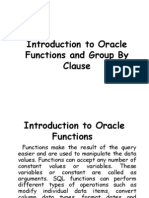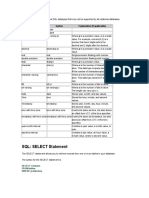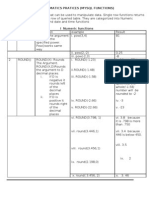0% found this document useful (0 votes)
10 views9 pagesFunctions
The document provides an overview of functions in SQL, categorized into predefined and user-defined functions. Predefined functions include aggregate functions like COUNT, SUM, AVG, MAX, and MIN, as well as single row functions such as arithmetic, character, date, and conversion functions. It also discusses the GROUP BY clause, HAVING clause, and the order of execution in SQL queries.
Uploaded by
nelapatidileep09Copyright
© © All Rights Reserved
We take content rights seriously. If you suspect this is your content, claim it here.
Available Formats
Download as TXT, PDF, TXT or read online on Scribd
0% found this document useful (0 votes)
10 views9 pagesFunctions
The document provides an overview of functions in SQL, categorized into predefined and user-defined functions. Predefined functions include aggregate functions like COUNT, SUM, AVG, MAX, and MIN, as well as single row functions such as arithmetic, character, date, and conversion functions. It also discusses the GROUP BY clause, HAVING clause, and the order of execution in SQL queries.
Uploaded by
nelapatidileep09Copyright
© © All Rights Reserved
We take content rights seriously. If you suspect this is your content, claim it here.
Available Formats
Download as TXT, PDF, TXT or read online on Scribd
/ 9





















































































